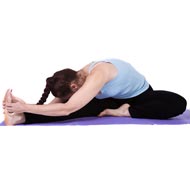- Aromatherapy (36)
- Benefits of Yoga (282)
- Home Remedies (1087)
- massage therapy (9)
- Preventive Therapy (135)
- Running (41)
- Skin Care (15)
- Stress Relief (25)
- Stretching (5)
- walking (33)
- Womens Health (14)
- Yoga Benefits for Pregnant Women (16)
- Yoga Benefits for Students (3)
- Yoga for Children (11)
- Yoga for Holistic Living (37)
- Yoga for Midlife Crisis (3)
- Yoga for Senior Citizens (2)
- Yoga for the Workplace (1)
- Yoga Health Tips (185)
- Yoga Practice during Menstruation (5)
Yoga To Prevent Mal-Absorption

Is There Any Alternative Medicine Or Yoga For Mal-Absorption
As you are aware, mal-absorption is a condition where nutrients do not get properly absorbed in the small intestine. This may be due to presence of organisms or enzyme deficiencies or atrophy of the small intestine. People suffering from mal-absorption lose weight and become anaemic and thin. This happens gradually and is mainly due to improper eating habits. Overeating, not eating, eating at irregular hours, eating too fast or too slow, eating when upset, angry or stressed and not having a balanced diet cause mal-absorption.
Yoga has great curative and corrective effect on persons suffering from mal-absorption. If you make it a part of your daily regimen and devote at least one hour with sincerity, you will definitely see the result.
The following yoga poses and breathing techniques are recommended:
- Adho Mukha Virasana (Face Down Hero’s Pose): Kneel on the floor with back erect. Rest hips between the feet with toes pointing backward. Spread the knees a little apart and bend trunk and chest forward between them allowing forehead to rest on the floor. Extend arms forward to rest on the floor. Stay in this pose breathing normally. Inhale and return to normal position.
- Pavanamuktasana (The Wind Relieving Pose): Lie on your back with your feet together. Exhale and bend both the knees and holding the shins with the locked hands, press your thighs towards the lower abdomen. Raise your head, shoulder and the upper portion of the chest and touch your forehead to the knees. Maintain the pose and breathe normally. Inhale and return to original position.
- Bhujangasana (The Cobra Pose): Lie on your stomach. Rest your forehead on the floor. Keep your feet together and both your arms close to your chest. Bend your elbows and bring the palms beneath your shoulder. Inhaling raise your head, neck, chest and upper abdomen off the floor. Keep the remaining portion of your body in close contact with the floor. Gaze upward bracing your shoulder backward. Maintain this pose and breathe normally. Exhale and return to original position.
- Salabhasana (The Locust Pose): Lie on your stomach with your forehead on the floor, the feet together and the toes pointing backwards. Place your arms close to the body, palms facing upwards. Inhale and raise both your legs backward as high as possible without raising your head or bending the knee. Maintain this position for as long as you can, breathing normally. Exhale and return to original position.
- Janu Sirshasana (Head to Knee Pose): Sit with your legs straight and back erect. Bend your right knee and place the right foot against the left thigh as high as possible. Twist towards left with your back straight to bring the chest in line with the left leg. Inhale and raise your arms.. Exhale and bend your chest and arms forward to hold both the sides of the left foot with both hands, resting your head on the leg and extended chest on the thigh. Maintain this pose breathing normally. Inhale and return to original position. Repeat the pose with the opposite leg as well.
- Paschimottanasana (Stretching Of The Back And Leg): Sit with your legs straight and back erect. Exhale and bend your trunk and head forward from the waist. Reach forward and hold each big toe with the hooks of the fingers of each hand. Pulling the big toes, bend forward further and rest your elbows on the floor. Rest your forehead on the knees. Maintain the pose and breathe normally. Inhale and return to original position.
- Shavasana (The Corpse Pose): Lie flat on the ground. The arms should be away from your body with palms facing upward and feet slightly apart. Close the eyes, try to loosen every organ, sinew and nerve of your body from head to toe and keep the mind free. Start breathing deeply, slowly and rhythmically.
In addition, sitting in Vajrasana or Diamond Pose for 5 minutes after meals is very effective for digestion of food. Along with yoga poses, practice rhythmic breathing of Kapalbhati (The Cleansing Breath) and Anuloma-Viloma (Alternate breathing) for half an hour. Pranayama is equally effective for digestion and assimilation. The combined practice of yoga poses and controlled rhythmic breathing not only rectifies and cures abdominal disorder, it also activates all the organs of the digestive system.
Last but not the least, have a balanced diet. Getting involved in social or community work may also help in reducing emotional stress.
- RSS Feeds -
- All posts
- All comments
- Are Vitamin C And Lemon Extract The Same Vitamin C is ascorbic acid, a water soluble compound. We need it to stay healthy...
- Good Walking Shoes If you are planning to start a regular walking program, one of the first thin...
- Walking Benefits Walking is an easy and beneficial exercise that can be done by almost everyon...
- Clothing For Yoga Yoga, like all other physical fitness programs also has to be practiced in sp...